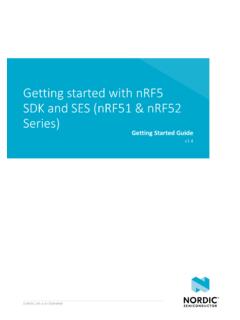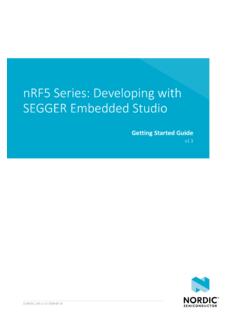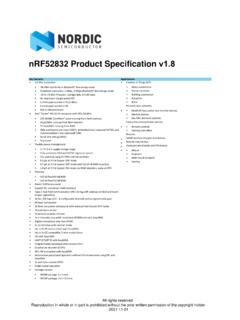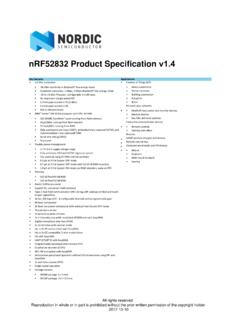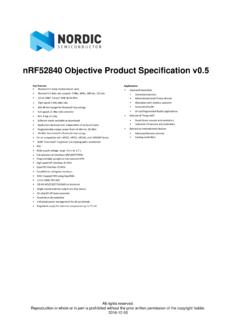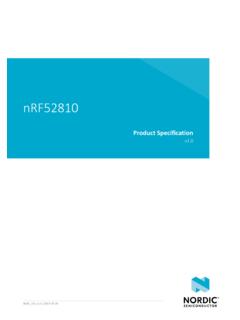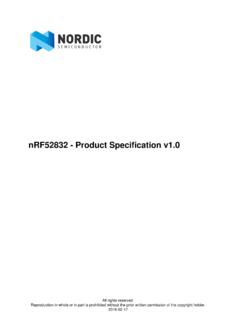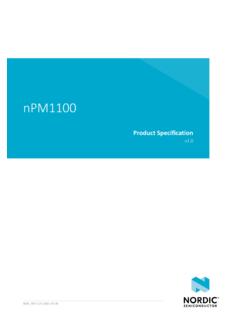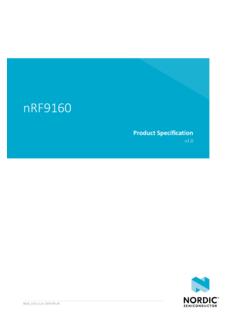Transcription of nRF52832 Development Kit v1.1
1 Doc. ID 4397_500 Development Kit ID 4397_500 2 ContentsRevision 1: 2: Setting up the Development 5 Chapter 3: Software 6 Chapter 4: Start 5: Interface IF Boot/Reset Virtual COM Dynamic Hardware Flow Control (HWFC) Interface MCU 6: Hardware Hardware Block Power Connector Buttons and I/O expander for buttons and kHz Measuring Preparing the Development kit Using an oscilloscope for current profile Using an ampere-meter for current RF Debug Debug NFC antenna Solder bridge ID 4397_500 3 Revision historyDateVersionDescriptionFebruary PDF for Development Kit (valid for all DK versions)Added MSD on page : Interface MCU firmware on page 9 Solder bridge configuration on page 27 Doc.
2 ID 4397_500 4 Chapter 1 IntroductionThe nRF52 Development Kit (DK and ) includes hardware, firmware source code, documentation,hardware schematics, and layout key features of the Development kit are: nRF52832 flash-based ANT/ANT+, Bluetooth low energy SoC solution Buttons and LEDs for user interaction I/O interface for Arduino form factor plug-in modules SEGGER J-Link OB debugger with debug out functionality Virtual COM port interface via UART Drag-and-drop mass storage device (MSD) programming Supporting NFC-A listen mode mbed enabledFor access to firmware source code, hardware schematics, and layout files, see 1: nRF52 Development Kit board (PCA10040) , 5 nRF52832 samples, and NFC tagDoc.
3 ID 4397_500 5 Chapter 2 Setting up the Development kitBefore you start developing, prepare your Development kit hardware by completing a few easy steps anddownload the required set up the hardware, follow the instructions in getting started with the nRF52 Development set up the software, follow the instructions in Nordic tools and downloads in nrf5 getting software required depends on your OS and Development ID 4397_500 6 Chapter 3 Software toolsThe extensive range of supporting software tools help you with testing and programming on your chip. S140 SoftDevice: Bluetooth low energy concurrent multi-link protocol stack solution supportingsimultaneous Central/Peripheral/Broadcaster/Observer role connections.
4 nrf5 SDK: The nrf5 Software Development Kit (SDK) provides source code of examples and librariesforming the base of your application Development . nRF5x Command Line Tools: nRF5x Tools is a package that contains JLinkARM, JLink CDC, nRFjprog, andmergehex. The nRFjprog is a command line tool for programming nRF5x Series chips. It is also useful in aproduction setup. See also nRF5x Command Line Tools. nRF5x-pynrfjprog: the nRF5x-pynrfjprog utility is a simple Python interface for the nrfjprog DLL. It isuseful for scripting, especially in automated tests. See also nRF5x pynrfjprog. nRFgo Studio: nRFgo Studio is a graphical user interface for programming nRF5x SoftDevices,applications, and bootloaders. nRF Connect for desktop: nRF Connect is a desktop application for getting familiar with, developing, andtesting Bluetooth low energy.
5 NRF Connect allows you to set up a local device, connect it to advertisingdevices and discover their services, maintain the connection and the connection parameters, pair thedevices and change the server setup for your local device. nRF Connect also offers a detailed log fortroubleshooting purposes. nRF Connect for mobile: nRF Connect for mobile is a powerful generic tool that allows you to scan andexplore your Bluetooth low energy devices and communicate with them on a smartphone. nRF Connectfor mobile supports a number of Bluetooth SIG adopted profiles together with the Device FirmwareUpdate (DFU) profile from Nordic also recommend some third party software tools that are useful when developing with our products: Keil MDK-ARM Development Kit: Keil MDK-ARM Development Kit is a Development environmentspecifically designed for microcontroller applications that lets you develop using the nrf5 SDK applicationand example files.
6 SEGGER J-Link Software: The J-Link software is required to debug using the J-Link hardware that ispackaged with our Development ID 4397_500 7 Chapter 4 Start developingAfter you have set up the Development kit and installed the toolchain, it is time to start are several ways to continue from here: Running precompiled examplesSee the step by step instructions on how you can quickly test a precompiled example without having touse the full toolchain, it is a matter of copying and pasting a precompiled hex file onto your developmentkit board. Compiling and running a first exampleTest that you have set up your toolchain correctly by compiling, programming and running a very simpleexample. Running examples that use a SoftDeviceBefore you can run more advanced examples that use Bluetooth or ANT, you must first program theSoftDevice on the ID 4397_500 8 Chapter 5 Interface MCUThe Interface MCU on the board is running either SEGGER J-Link OB or mbed OB interface firmware and is usedto program and debug the firmware of the nRF52832 2: Interface IF Boot/Reset buttonThe nRF52 Development Kit board is equipped with an IF (Interface) Boot/Reset button (SW5).
7 This button is connected to the interface MCU on the board and has two functions: Resetting the nRF52832 device. Entering bootloader mode of the interface normal operation the button will function as a reset button for the nRF52832 device. For this towork, pin reset on needs to be enabled for the nRF52832 device. The button is also used to enter thebootloader mode of the interface MCU. To enter bootloader mode, keep the reset button pressed whilepowering up the board until LED (LD5) starts to blink. You can power up the board either by disconnectingand reconnecting the USB cable, or toggle the power switch (SW6).Important: Pin reset can be enabled by defining the CONFIG_GPIO_AS_PINRESET variablein the project settings.
8 This can be done by defining the preprocessor symbol in Keil, go to:Project > Options for Target > C/C++ > Preprocessor Symbols > Define. Here you can add theCONFIG_GPIO_AS_PINRESET variable after functionality can be removed by doing a nRFjprog Virtual COM portThe on-board interface MCU features a virtual COM port via Interface MCUDoc. ID 4397_500 9 The virtual COM port has the following features: Flexible baud rate setting up to 1 Dynamic hardware flow control (HWFC) handling. Tri-stated UART lines when no terminal is 1: Relationship of UART connections on nRF52832 and the interface MCU on page 9 shows anoverview of the UART connections on nRF52832 and the interface 1: Relationship of UART connections on nRF52832 and the interface MCUD efault GPIO nRF52832 UART nRF52832 Interface MCU UART signals are routed directly to the interface MCU.
9 The UART pins connected to the interface MCU aretri-stated when no terminal is connected to the virtual COM port on the : The terminal software used must send a DTR signal in order to configure the UART interface MCU (RTS) and (CTS) can be used freely when HWFC is disabled on the : The mbed OB interface does not support HWFC through the virtual com Dynamic Hardware Flow Control (HWFC) handlingWhen the interface MCU receives a DTR signal from a terminal, it performs automatic HWFC HWFC detection is done by driving (CTS) from the interface MCU and evaluating the state (RTS) when the first data is sent or received. If the state of (RTS) is high, HWFC is assumed not tobe used. If HWFC is not detected, both CTS and RTS can be used freely by the nRF a power-on reset of the interface MCU, all UART lines are tri-stated when no terminal is connected tothe virtual COM port.
10 Due to the dynamic HWFC handling, if HWFC has been used and detected, (CTS)will be driven by the interface MCU until a power-on reset has been performed or until a new DTR signal isreceived and the detection is redone. To ensure that the UART lines are not affected by the interface MCU,the solder bridges for these signals can be cut and later resoldered if needed. This might be necessary if UART without HWFC is needed while (RTS) and (CTS) are used for other Interface MCU firmwareThe on-board interface MCU is factory programmed with an mbed compliant bootloader. This feature makes itpossible to swap interface firmware between the factory preloaded SEGGER J-Link OB and the mbed section IF Boot/Reset button on page 8 on how to enter the swap interface MCU firmware, simply drag the Interface image (.)
